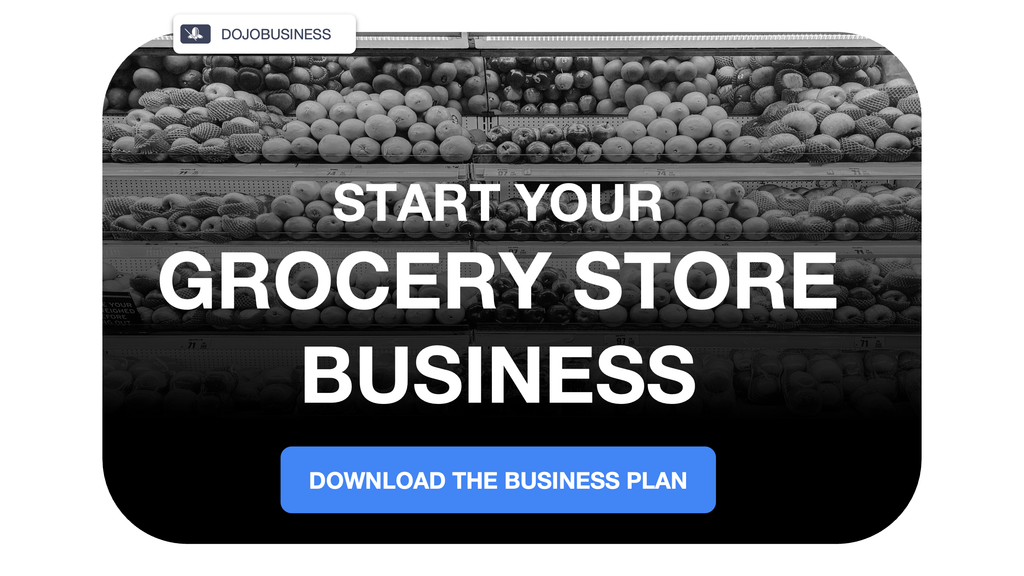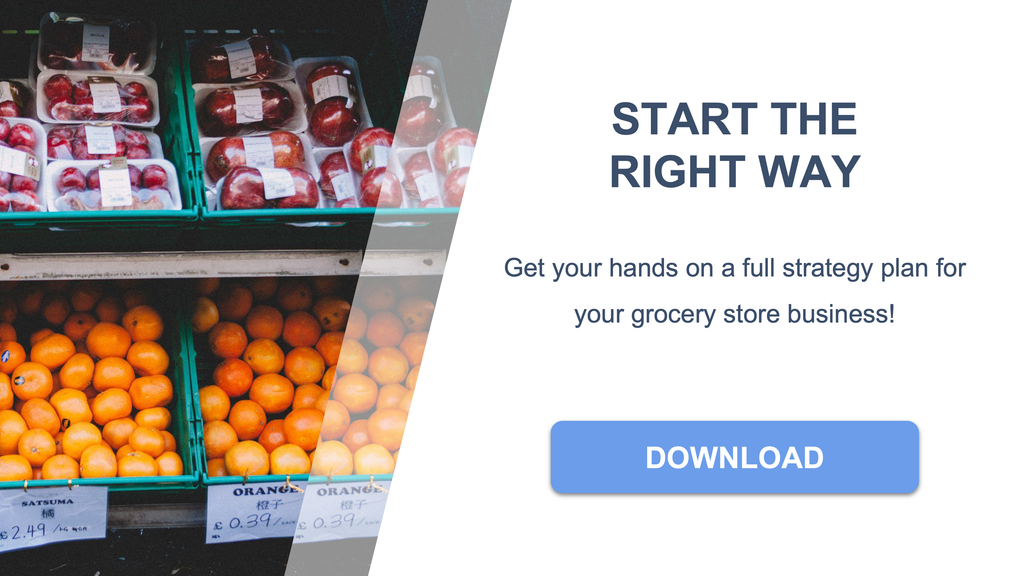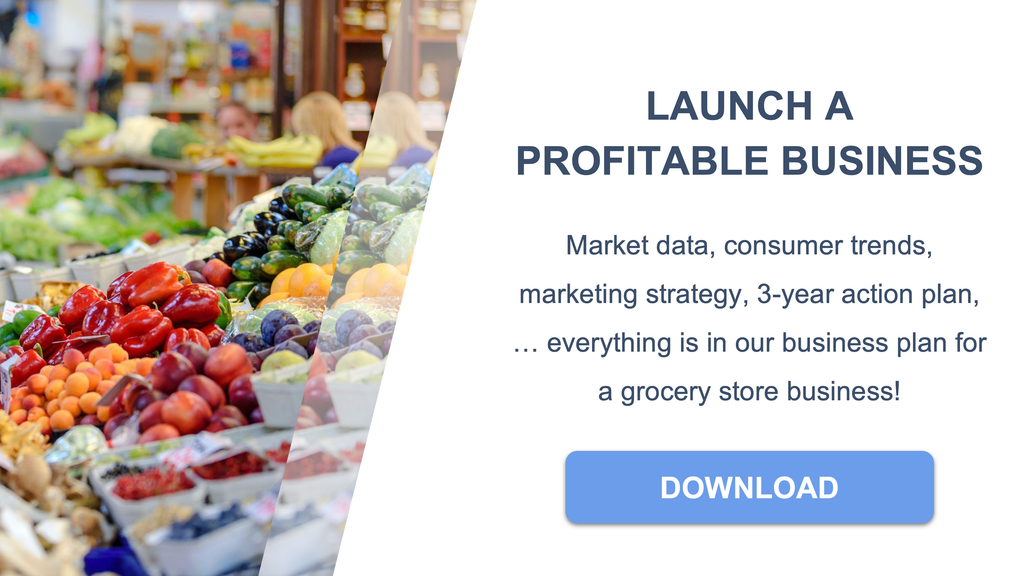This article was written by our expert who is surveying the industry and constantly updating the business plan for a grocery store.

Opening a successful grocery store requires strategic planning, adequate funding, and deep understanding of local market dynamics.
The grocery retail industry offers significant opportunities for entrepreneurs who can navigate location selection, inventory management, and customer satisfaction effectively. Success depends on choosing high-traffic locations, maintaining optimal product mix, and implementing efficient operational systems.
If you want to dig deeper and learn more, you can download our business plan for a grocery store. Also, before launching, get all the profit, revenue, and cost breakdowns you need for complete clarity with our grocery store financial forecast.
This comprehensive guide provides essential information for opening and operating a profitable grocery store business.
The following table outlines key success factors and requirements for launching a grocery store operation.
| Success Factor | Requirements | Expected Investment/Results |
|---|---|---|
| Location Selection | High foot traffic areas near schools, hospitals, main roads with ample parking | Rent: $20,000-$250,000 depending on size and location |
| Initial Investment | Inventory, equipment, licensing, renovations, working capital | Small store: $80,000-$300,000 | Large store: $400,000-$1,000,000 |
| Legal Compliance | Business license, food permits, PACA license (if applicable), zoning approval | $5,000-$30,000 in licensing and permit costs |
| Working Capital | 3-6 months of operating expenses in cash reserves | $75,000-$150,000 for monthly expenses of $25,000 |
| Profit Margins | Efficient inventory management, competitive pricing, supplier negotiations | Gross margin: 20-30% | Net profit: 1-5% |
| Break-even Point | Daily customer traffic matching fixed costs and desired profit | ~42 customers per day with $20 average transaction for $25,000 monthly costs |
| Technology Systems | POS system, inventory management software, accounting tools | $10,000-$50,000 for comprehensive technology stack |

What kind of neighborhood or location offers the best foot traffic and customer base for a profitable grocery store?
High-traffic locations near essential services and transportation hubs provide the strongest foundation for grocery store profitability.
Target areas near schools, hospitals, banks, and busy intersections where people naturally congregate throughout the day. These locations generate consistent foot traffic from diverse customer segments including families, working professionals, and students.
Accessibility remains crucial for grocery store success. Ensure your location offers easy access by foot, car, and public transportation with adequate parking for both customers and delivery vehicles. Sites with clear visibility from main roads and simple entry/exit points perform significantly better than hidden or difficult-to-reach locations.
Analyze local demographics focusing on population density, household income levels, and shopping patterns. Diverse, densely populated neighborhoods with established residential communities typically provide stable customer bases. Areas with mixed-income levels allow you to serve both value-conscious shoppers and premium product customers.
You'll find detailed market insights in our grocery store business plan, updated every quarter.
What are the startup costs involved in opening a grocery store, including inventory, rent, equipment, and licensing?
Grocery store startup costs typically range from $80,000 to $1,000,000 depending on store size, location, and target market positioning.
| Cost Category | Small Store (2,000-5,000 sq ft) | Large Store (10,000+ sq ft) |
|---|---|---|
| Initial Inventory | $40,000 - $100,000 | $200,000 - $300,000 |
| Rent & Renovations | $20,000 - $60,000 | $100,000 - $250,000 |
| Equipment (refrigeration, shelving, POS) | $10,000 - $50,000 | $50,000 - $150,000 |
| Licensing & Permits | $5,000 - $15,000 | $10,000 - $30,000 |
| Marketing & Signage | $5,000 - $20,000 | $20,000 - $50,000 |
| Working Capital | $15,000 - $30,000 | $50,000 - $100,000 |
| Miscellaneous (insurance, security) | $5,000 - $20,000 | $20,000 - $50,000 |
| Total Investment | $100,000 - $295,000 | $450,000 - $930,000 |
What are the key legal and regulatory requirements to open and operate a grocery store in this area?
Grocery stores must comply with multiple federal, state, and local regulations covering food safety, business operations, and public health standards.
Start with obtaining a general business license from your local municipality and register your business entity (LLC, corporation, or partnership) with the appropriate state agency. This foundation enables you to operate legally and opens access to other required permits.
Food handling and safety permits from local health departments are mandatory for all grocery operations. These permits require regular inspections, proper food storage temperatures, sanitation protocols, and staff training certifications. Renewal typically occurs annually with associated inspection fees.
PACA (Perishable Agricultural Commodities Act) licensing becomes required if you sell over 2,000 pounds of fresh or frozen produce daily or if your annual invoice cost exceeds $230,000. This federal license protects produce transactions and requires annual renewal with bonding requirements.
Additional compliance areas include zoning approval for retail food sales, fire safety inspections, building code compliance, and signage permits. If selling alcohol or tobacco products, separate licensing applies with age verification requirements and additional regulatory oversight.
How much working capital is typically needed to cover operational costs for the first 3 to 6 months?
Maintain 3-6 months of operating expenses in cash reserves to ensure smooth operations during the initial startup phase and seasonal fluctuations.
Calculate monthly fixed costs including rent, utilities, insurance, and minimum staffing requirements. Add variable costs such as inventory replenishment, marketing expenses, and equipment maintenance. For example, if total monthly expenses equal $25,000, maintain $75,000-$150,000 in working capital.
Grocery stores experience unpredictable cash flow patterns due to seasonal buying, supplier payment terms, and customer payment delays. Adequate working capital prevents stockouts during high-demand periods and covers unexpected expenses like equipment repairs or regulatory compliance costs.
This is one of the strategies explained in our grocery store business plan.
What size and layout should the store be to optimize customer flow and product visibility?
Store size should match your target market density and competition level, typically ranging from 2,000 square feet for neighborhood stores to 40,000 square feet for suburban locations.
Small neighborhood stores (2,000-5,000 sq ft) work well in dense urban areas with frequent shopping patterns and limited parking. These formats focus on convenience items, fresh produce, and daily essentials with quick customer turnover.
Larger formats (10,000-40,000 sq ft) suit suburban locations with family shopping patterns and car-based access. These stores accommodate full grocery selections including bulk items, extensive frozen sections, and specialty departments like bakery or deli.
Grid layout maximizes shelf space utilization and guides customers through all product categories systematically. Place high-demand staples like milk, bread, and eggs at the store's back to increase customer exposure to other products during their shopping journey.
Position fresh produce at the entrance to create positive first impressions and encourage impulse purchases. Use clear signage and logical product groupings to help customers navigate efficiently while discovering new items.
What product categories and price ranges should be prioritized to balance demand and profitability?
Focus on essential categories that drive frequent customer visits while incorporating higher-margin specialty items to boost profitability.
Core categories include fresh produce, dairy products, bread and bakery items, meat and seafood, canned and packaged goods, snacks and beverages, frozen foods, and household/personal care items. These categories fulfill basic customer needs and generate consistent sales volume.
Implement a balanced pricing strategy mixing value brands for price-conscious customers with premium options for higher margins. Monitor local competitor pricing regularly while maintaining profitability targets through strategic supplier negotiations and efficient operations.
Local and organic products often command premium pricing while building customer loyalty and community connections. These specialty items can achieve gross margins of 35-50% compared to 15-25% for conventional staples.
We cover this exact topic in the grocery store business plan.
What are the best strategies to source suppliers and negotiate favorable margins on inventory?
Build diverse supplier relationships combining local producers, regional distributors, and national wholesalers to optimize costs and product freshness.
Direct relationships with local farmers and food producers reduce intermediary costs while ensuring product freshness and supporting community connections. These partnerships often provide better margins and unique products that differentiate your store from competitors.
Negotiate volume discounts and favorable payment terms with distributors and wholesalers. Consolidate purchases across multiple product categories to increase bargaining power and reduce per-unit costs. Standard industry payment terms range from net 15 to net 30 days, improving cash flow management.
Implement supplier performance tracking systems monitoring delivery reliability, product quality, and pricing consistency. Maintain backup suppliers for critical categories to prevent stockouts and leverage competitive pricing negotiations.
Consider joining buying cooperatives or group purchasing organizations to access better pricing typically available only to larger chains. These partnerships can reduce costs by 5-15% on many product categories.
What are the average gross margin and net profit margin a well-run grocery store should aim for?
Well-operated grocery stores typically achieve gross margins of 20-30% and net profit margins of 1-5% after all operational expenses.
| Product Category | Typical Gross Margin | Volume Impact | Profit Strategy |
|---|---|---|---|
| Fresh Produce | 25-40% | High frequency purchases | Focus on turnover speed |
| Meat & Seafood | 20-35% | Higher transaction values | Quality and service premium |
| Dairy Products | 15-25% | Essential daily items | Competitive pricing for traffic |
| Packaged Goods | 18-28% | Consistent volume | Bulk purchasing discounts |
| Frozen Foods | 20-30% | Convenience factor | Extended shelf life advantage |
| Health & Beauty | 30-50% | Lower volume, higher margin | Premium positioning |
| Household Items | 25-40% | Impulse and convenience | Strategic placement |
How many customers and how much revenue per day or per week is needed to break even and stay profitable?
Break-even calculations depend on fixed costs, average transaction values, and gross margin percentages specific to your store's operational structure.
For a store with $25,000 monthly fixed costs and $20 average transaction value, you need approximately 1,250 transactions monthly or 42 customers daily to cover basic expenses. This assumes a 25% gross margin and excludes owner compensation.
Weekly revenue targets should account for seasonal fluctuations and day-of-week variations. Grocery stores typically see 20-30% higher sales on weekends, requiring approximately 300-350 transactions weekly to maintain profitability at the example cost structure.
Customer frequency matters more than individual transaction size for grocery store sustainability. Focus on building a base of regular customers shopping 2-3 times weekly rather than depending on occasional large purchases from infrequent visitors.
It's a key part of what we outline in the grocery store business plan.
What are the most effective marketing tactics to attract and retain loyal, local grocery customers?
Community-focused marketing strategies combining promotional pricing, local engagement, and exceptional customer service drive long-term customer loyalty in grocery retail.
Implement loyalty programs offering discounts on frequently purchased items and exclusive promotions for regular customers. Digital punch cards, points-based systems, and personalized offers based on purchase history increase customer retention rates by 15-25%.
Host community events such as cooking demonstrations, local vendor showcases, and seasonal celebrations to build neighborhood connections. These activities position your store as a community hub while introducing customers to new products and services.
Maintain strong digital presence through social media updates, Google My Business optimization, and local directory listings. Share daily specials, new product arrivals, and community involvement to stay visible in local search results and social feeds.
Focus on creating exceptional in-store experiences through clean facilities, well-organized displays, helpful staff, and efficient checkout processes. Word-of-mouth referrals from satisfied customers remain the most effective marketing for neighborhood grocery stores.
How should inventory and spoilage be managed to avoid losses and maximize shelf turnover?
Effective inventory management requires real-time tracking systems, strategic markdown policies, and data-driven ordering decisions to minimize waste and optimize cash flow.
Implement POS systems with integrated inventory management tracking expiration dates, sales velocity, and stock levels by product category. These systems alert managers to slow-moving items requiring markdown or promotional pricing before spoilage occurs.
Establish systematic markdown schedules for perishable items approaching expiration dates. Reduce prices by 25% at 3 days before expiration, 50% at 1 day before, and consider donating unsold items to local food banks for tax benefits and community goodwill.
Use sales data analytics to optimize order quantities and delivery schedules. Track historical sales patterns, seasonal trends, and local events affecting demand to prevent both stockouts and overstocking situations.
Train staff on proper storage procedures, rotation protocols (first-in, first-out), and temperature monitoring for different product categories. Proper handling can extend product life by 2-5 days, significantly reducing spoilage costs.
What tools, systems, or software are essential to efficiently manage sales, inventory, and staff operations?
Modern grocery store operations require integrated technology systems managing point-of-sale transactions, inventory control, staff scheduling, and financial reporting.
| System Category | Essential Features | Estimated Investment |
|---|---|---|
| POS System | Transaction processing, inventory tracking, sales reporting, customer management | $3,000 - $15,000 initial + monthly fees |
| Inventory Management | Real-time stock levels, automated reordering, expiration tracking, shrinkage monitoring | $200 - $800 monthly subscription |
| Staff Scheduling | Labor cost optimization, availability tracking, payroll integration, compliance monitoring | $100 - $400 monthly per location |
| Accounting Software | Financial reporting, cash flow management, tax preparation, vendor payment tracking | $50 - $300 monthly subscription |
| Supplier Management | Order processing, delivery tracking, performance monitoring, contract management | $150 - $500 monthly subscription |
| Security Systems | Surveillance cameras, alarm systems, access control, loss prevention monitoring | $5,000 - $20,000 initial installation |
| Customer Loyalty | Points tracking, promotional campaigns, customer analytics, marketing automation | $100 - $500 monthly subscription |
Conclusion
This article is for informational purposes only and should not be considered financial advice. Readers are encouraged to consult with a qualified professional before making any investment decisions. We accept no liability for any actions taken based on the information provided.
Success in grocery retail requires careful planning, strategic location selection, and efficient operational systems.
By focusing on customer service, inventory management, and community engagement, new grocery store owners can build profitable, sustainable businesses serving their local markets.
Sources
- OK Credit - How to Choose Location for Grocery Store
- Shopify - Retail Location Guide
- Firework - Increase Foot Traffic Your Grocery Store
- IT Retail - How Much Does it Cost to Open a Grocery Store
- Wolters Kluwer - Grocery Store Business License Requirements
- PlanoHero - Grocery Store Layout Strategy
- POS Nation - Grocery Store Profit Margins
- Dojo Business - Grocery Store Break Even Shoppers
- Cloud Cover Music - Grocery Store Marketing
- Markt POS - Grocery Store Software
-Grocery Store Business Plan Guide
-Understanding Grocery Store Profit Margins
-Maximizing Grocery Profit Margins
-Grocery Store Monthly Income Expectations
-Daily Revenue Targets for Grocery Stores
-Cost to Build a Grocery Store
-Cost to Buy an Existing Grocery Store
-Complete Cost Breakdown to Open a Grocery Store



